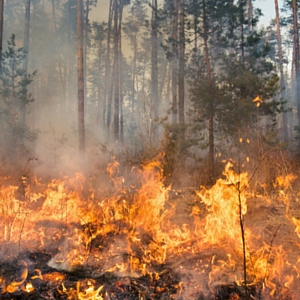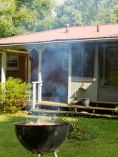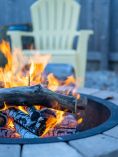Wildfires: Prevention and Planning are Key to Protection

Wildfires are large, uncontrolled fires that typically occur in heavily wooded areas or grassy fields, and they put homes in or surrounding these areas at risk. According to the National Interagency Fire Center (NIFC) more than 67,000 wildfires burned over 5.5 million acres in 2016. The fires impacted more than 3,000 homes and more than 7,000 commercial buildings. If you live or own a business near an at-risk area, check out our planning tips to prevent wildfires from engulfing your property.
Prevention
Smoky Bear said, "Only YOU can prevent wildfires," and National Geographic indicates that four out of five wildfires are started by people. Natural causes like lightning are possible, but rarer. Most of these fires are not intentionally set, but when conditions are dry, all it takes is an ignition source, high winds and dry plants or trees to spark a wildfire—even if it's an accident. While you can't control the weather, you can pay attention to when conditions are right for a wildfire to occur and avoid leaving campfires unattended, burning trash, flicking a cigarette or any other similar activities that can cause a fire to start.
If your home is near a wooded area or grassy field, it could be at risk if there's a wildfire. Fortunately, there are precautions you can take:
- Create a defensible space of 30 feet or more around your home.
- Check the siding all around your house to be sure it isn't touching the ground.
- Keep wood piles at least 30 feet from your home.
- Sweep dry leaves and pine needles away from your home.
- Prune trees and trim branches that are low to the ground, above the roof or near a chimney.
- Install a roof with a fire classification of Class A.
- Make sure your roof and gutters are clean.
- Remove climbing vines from your house.
- Keep the grass mowed.
If wildfires are in your area, keep your yard and landscaping wet. In addition, it may help to wet the roof if you have wood shingles. If you have anything outside that's flammable such as wooden or wicker outdoor furniture, propane tanks for grills, gas cans, etc., move them indoors so an ember cannot ignite it.
Planning
Hopefully wildfires will never threaten your home, but planning for the worst can leave you with a better outcome if it happens.
- Close windows and remove lightweight curtains.
- Open your fireplace damper and close fireplace doors or screens.
- Make sure your smoke detectors work.
- Keep an adequate number of working fire extinguishers in the house and make sure everyone in the house knows how to use them.
- Review your homeowners insurance policy and keep an accurate list of the contents of your home.
- Know your evacuation route and have a disaster kit packed and ready to go, including a fireproof safe with all of your important documents, photos, etc.
Above all, if you are ordered to evacuate, heed those orders. Your house can be replaced, but your family can't. Choose safety.
-
Keep it Fun
 Get Tips
Get TipsAfter you’ve prepped your home to keep it safe from wildfires, dive into these tips on how to enjoy the rest of your summer safely.
-
Keep it Away
 Grill Safely
Grill SafelyThere’s nothing quite like the smell of grilling out. Before you fire yours up, make sure you know what you’re doing so the fire stays in the grill.
-
Keep it Contained
 Get Know-How
Get Know-HowFire pits aren’t just for spring and fall. They’re great for making s’mores and backyard campouts too—just don’t catch the yard on fire.
